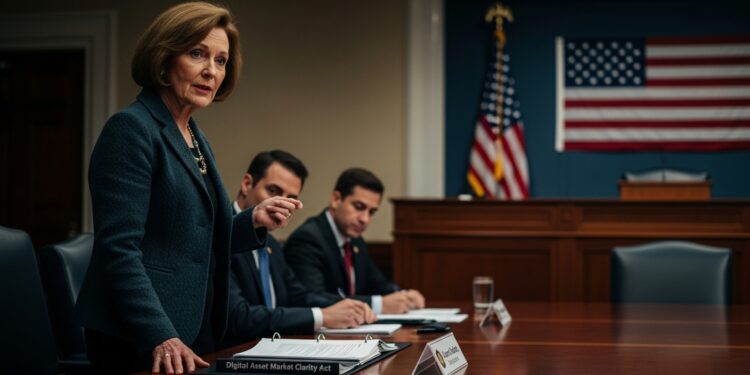The clock is ticking in Washington. A familiar deadline looms for crypto legislation. Senator Cynthia Lummis, a Republican from Wyoming, has her sights set on passing a market structure bill before the year is out. She even hopes it lands on President Trump’s desk before Thanksgiving. It’s an ambitious goal, given the usual pace of things on Capitol Hill.
- Senator Cynthia Lummis aims to pass crypto legislation by year-end, potentially using the House’s Digital Asset Market Clarity Act as a base.
- This strategic shift acknowledges the procedural difficulties in the Senate and leverages the bipartisan support the House bill received.
- The goal is to define digital asset classification and regulation, providing clarity for growth, investment, and consumer protection in the crypto space.
But there’s a twist in the strategy this time. Instead of pushing a purely Senate-born bill, Lummis and her colleagues are looking to the House of Representatives. They plan to use the House’s recently passed Digital Asset Market Clarity Act as their starting point, their “base bill.”
This shift comes after months of back-and-forth. Just last month, Senator Lummis, along with Senators Bill Hagerty, Bernie Moreno, and Senate Banking Committee Chair Tim Scott, released their own discussion draft for a larger crypto market structure. They had set a self-imposed deadline of September 30 for action within that committee. That version, it turns out, was quite different from what the House had in mind.
So, why the change of heart? Lummis put it plainly during a panel at the Wyoming Blockchain Symposium. She said the Senate is “a mess procedurally.” Anyone who follows legislative wrangling knows that feeling. It’s like trying to herd cats, if the cats also had very strong opinions on blockchain consensus mechanisms.
The House’s Clarity Act, however, offers a clear path. It passed with strong bipartisan support. Seventy-eight Democrats voted in favor of that bill. That’s a significant number in today’s political climate. It shows a rare moment of agreement across the aisle.
Lummis wants to “honor the House’s work,” as she put it. She sees the broad support for the Clarity Act as something worth preserving. “We don’t want to disrupt that very much,” she explained. It’s a pragmatic approach. Why reinvent the wheel when another chamber has already built a pretty good one, and gotten a lot of folks to agree on it?
A Senate aide confirmed this thinking. Senator Lummis believes the House did good work on Clarity. She wants to keep as much of it as possible. But, and this is a big “but,” there will be changes. Legislation is rarely a copy-paste job. It’s more like a collaborative art project, where everyone adds their own brushstrokes, sometimes in conflicting colors.
The House, for its part, has been busy. Last month, they didn’t just pass the Clarity Act. They also sent the stablecoin GENIUS Act to President Trump’s desk. The Clarity Act itself moved on to the Senate. So, the ball is firmly in the Senate’s court now, with a new playbook.
What does this mean for the crypto world? It means the conversation about how digital assets are regulated is heating up. It means there’s a tangible piece of legislation, the Clarity Act, that could become the foundation for federal rules. This is a big step. For years, the industry has asked for clear rules of the road. This bill aims to provide some of that clarity.
Think of it like this: Imagine you’re building a house. For a long time, you’ve been working with vague blueprints, not quite sure if your walls are up to code. Now, Congress is trying to hand you a more detailed set of plans. The House has drawn up one version, and the Senate is saying, “Okay, let’s start with yours, but we’ll add a few tweaks here and there.”
The details of these changes will be important. What aspects of the House bill will the Senate keep? What will they modify? Will the bipartisan spirit that carried the Clarity Act through the House survive the Senate’s procedural “mess”? These are the questions I’ll be watching closely.
The goal of a market structure bill is to define how digital assets are classified and regulated. Are they securities? Commodities? Something else entirely? Getting clear answers to these questions could unlock significant growth and investment in the space. It could also provide much-needed consumer protections.
For years, the crypto industry has operated in a gray area. This has led to uncertainty for businesses and investors alike. A clear framework could bring more mainstream players into the fold. It could also help weed out bad actors, making the entire ecosystem safer.
Senator Lummis’s push for a year-end deadline shows a genuine desire to get something done. It’s a tight timeline, especially with the holidays approaching. But the fact that they’re willing to adopt the House’s work as a base bill suggests a pragmatic approach to legislative success. It’s a recognition that sometimes, you have to compromise to make progress.
So, we wait and watch. Will the Senate manage to turn the House’s Clarity Act into a bill that can pass both chambers and reach President Trump’s desk? Will Thanksgiving dinner conversations in Washington include whispers of crypto legislation? Only time will tell, but the stage is set for a busy few months in digital asset policy.

















